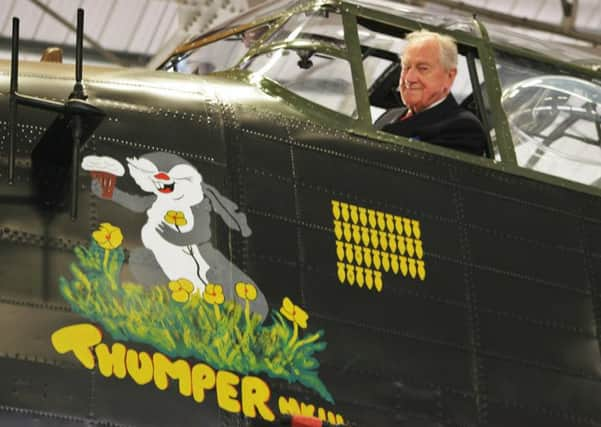Daring Dambuster raids are remembered 70 years on


It was at this time that Barnes Wallis, a previous pupil at Christ’s Hospital in Horsham, invented the ‘bouncing bomb’ that secured the raid’s success.
Storrington resident John Bell remembers the media buzz surrounding the Dambusters and was keen to join 619 squadron at just 18-years-old in June 1943, before stepping up to 617 squadron. Now at 90 he recalls his 15 months of operations vividly.
Advertisement
Hide AdAdvertisement
Hide Ad“I couldn’t be a pilot because I was too long in the leg, and they told me I’d have difficulty getting out of the cockpit, so they said I had to be a navigator,” he said.
Most of Mr Bell’s training in navigation, bombing and gunnery for the Lancaster aircraft took place overseas in South Africa and Canada.
“We weren’t aware at all of what was required of us. We were all young and not particular about the dangers ahead.”
Without a second thought or concern for his life, Mr Bell explained that it was natural to join up and do your bit for the country.
“All your friends were going.”
Advertisement
Hide AdAdvertisement
Hide AdIn fact, it was the friendships that Mr Bell formed within his crew of seven that he fondly remembers.
“We were particularly close in the crew. You lived together, you fought together and your lives were entwined.
“It reached a point where the crew continued flying because they didn’t want to be split up, whereas we could have stopped for a rest.”
As a bomb aimer, Mr Bell’s crew focused on single targets like factories and marshalling yards across Berlin, Munich and Hamburg to name a few.
Advertisement
Hide AdAdvertisement
Hide Ad“I guided the pilot onto a specific target, you didn’t just scatter them anywhere.”
Using a gadget, that worked much like a computer, Mr Bell could identify the speed of the aircraft, the height above ground and the wind direction, which all affect where the bomb lands. Even the bomb characteristics had to be taken into consideration.
“When a bomb is released from an aircraft it’s being thrown forward at the same speed, and so that curve of drop needs to be taken into account.”
A complicated system to master, Mr Bell admitted that the risks were incredibly high during the night time raids.
Advertisement
Hide AdAdvertisement
Hide Ad“Collisions were quite easy and the other danger were the bombs from other aircrafts above - we had several near misses.
“Our plane was damaged by anti-aircraft fire and the sky was always filled with shell bursts, so there was a lot of metal flying around that you had to watch out for.”
Missions would take between five and nine hours, and many squadron members would fear of not returning, but Mr Bell remained positive.
“You always think that you’re going to survive, you have to have that in your mind.
Advertisement
Hide AdAdvertisement
Hide Ad“I saw other aircrafts going down in flames and occasionally see someone getting out in a parachute, and if they survived they could be strung up by civilians or shot - the SS could be very cruel.
“You become rather nonchalant about it I’m afraid, you take a view that it’s fortunately not yourself.”
Completing his duty as a bomb aimer in August 1944, Mr Bell became a bombing instructor on an operational training unit.
“I was a schoolboy just before I joined. The war made me a different person.
Advertisement
Hide AdAdvertisement
Hide Ad“Now when I get into a Lancaster I recall all the smells, the feel and remember the small space inside.
“It’s nice to be able to drag these memories back out.”
Just nine months before Mr Bell joined 617 squadron Barnes Wallis (nickname ‘Old Blue’) invented the ‘bouncing bombs’ that led the Dambusters to victory in destroying two German dams in May 1943.
Last September, to mark the 125th anniversary of the birth of Sir Barnes Wallis, members of his family were joined by a number of RAF representatives at Christ’s Hospital, including squadron leader George Johnson.
John Bell features in ‘Voices in Flight: The Dambuster Squadron’ to coincide with the 70th anniversary of the raid.
Advertisement
Hide AdAdvertisement
Hide AdTo celebrate the Dambusters’ death defying mission on May 16 and 17 1943, ‘Voices in Flight: The Dambuster Squadron’ has been released today featuring first-hand accounts from 617 squadron members. Co-authored by Colin Higgs and Bruce Vigar, this evocative book serves as a memorial to the veterans whose exploits characterise these most iconic raids. Mr Higgs explains: “This is the first of a series of books that will give a good opportunity to tell the whole story.”
The book features nine crew interviews covering the early days of 617 squadron that saw 19 aircrafts attack two German dams, but losing eight in the process.
Several years ago the authors started a project to document as many veteran interviews as possible. “We’re trying to capture a short period of time, which had never happened before and will never happen again,” Mr Higgs continued to explain that many of the squadron members believed it was the best time of their lives.
“It’s vital we record the memories and the comradships.
“What amazes me is that there are men who in their old age can’t remember what they had for breakfast, but can tell you everything about the war in great detail.”
Featuring an interview from John Bell, ‘Voices in Flight: The Dambuster Squadron’ is out now by Pen & Sword Books Ltd, available from Amazon for £16 and at www.pen-and-sword.co.uk